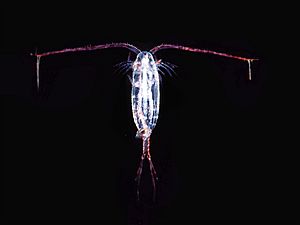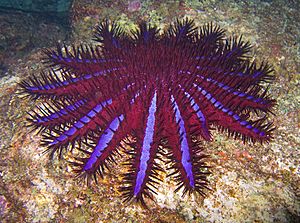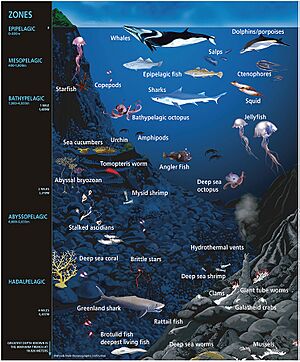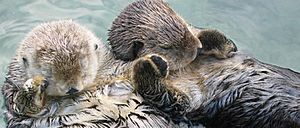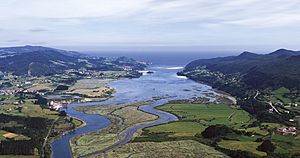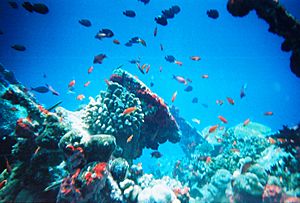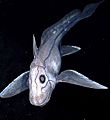Marine biology facts for kids
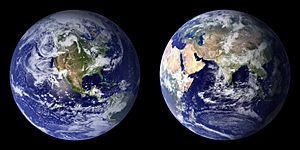
Marine biology is the study of all living things in the sea. This includes tiny plants and animals, as well as huge whales. Marine biologists are the scientists who study them. They learn about the creatures and how the ocean works. Understanding how the sea works is called oceanography.
There are many different kinds of marine animals and plants. Some examples are squids, corals, whales, fish, sea grasses, and algae. Scientists once did a big project called the Census of Marine Life to count and study all the life in the ocean.
Contents
Marine Life: Who Lives in the Ocean?
Tiny Life: Microbes and Plankton
The ocean is full of tiny living things called microbes. They are super important because they help run all the global systems on Earth. Microbes do almost all the photosynthesis in the ocean. This means they make their own food using sunlight, just like plants on land. They also help move important nutrients like carbon and nitrogen around the ocean.
There are many different kinds of tiny life in the sea, and we are still learning about them. Even tiny viruses play a role in ocean ecosystems.
One very important group of tiny life is phytoplankton. These are like the plants of the ocean. They are the main producers of food for many other creatures. Phytoplankton include things like cyanobacteria (blue-green algae), different types of algae, and diatoms.
Then there's zooplankton. These are tiny animals that float in the water. Many Protozoa are zooplankton. Some zooplankton are even tiny versions of bigger animals, like fish larvae or baby starfish.
Ocean Plants and Algae
Tiny algae and larger plants create important homes for ocean life. They offer hiding spots for baby fish and places for small animals to find food.
Algae are very common and diverse in the ocean. Even tiny photosynthetic algae make more oxygen than all the forests on land combined! Large algae, like Sargassum and kelp, are often called seaweeds. They can grow into huge underwater "forests" called kelp forests.
Plants that grow in the sea are usually found in shallow waters. These include seagrasses like eelgrass. They have special ways to live in salty ocean water. You can also find plants like mangroves and cordgrass in the intertidal zone, which is the area near the shore that gets covered and uncovered by tides.
Invertebrates: Animals Without Backbones
Just like on land, invertebrates make up a huge part of ocean life. These are animals that do not have a backbone. There are over a million different kinds!
Some examples of ocean invertebrates include:
- Cnidaria like jellyfish and sea anemones.
- Ctenophora, also known as comb jellies.
- Many types of sea worms.
- Mollusca, which includes shellfish, squid, and octopus.
- Arthropoda, like crabs and shrimp.
- Porifera, which are sponges.
- Echinodermata, like starfish and sea urchins.
- Urochordata, like sea squirts.
Fungi: Ocean Decomposers
Over 1,500 types of fungi live in the ocean. They often live on marine algae or animals, or they break down dead plants and animals. Fungi can also be found in sea foam. Many marine fungi have special parts that help them stick to surfaces underwater.
Vertebrates: Animals With Backbones
Fish
There are over 33,400 known species of fish! This is more than all other vertebrates (animals with backbones) combined. About 60% of all fish species live in saltwater. Fish can be bony (like tuna) or cartilaginous (like sharks and rays).
Reptiles
Reptiles that live in or visit the sea include sea turtles, sea snakes, and the saltwater crocodile. Most marine reptiles lay their eggs on land, so they need to return to the shore. Sea snakes, however, often prefer shallow, calm waters near land. Some ancient marine reptiles, like ichthyosaurs, gave birth to live young in the water.
Birds
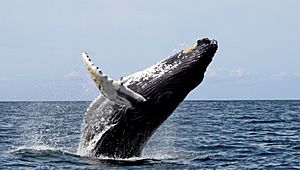
Birds that live in the marine environment are called seabirds. Examples include albatross, penguins, and gannets. Even though they spend most of their lives in the ocean, some seabirds, like gulls, can be found far inland.
Mammals
There are five main groups of marine mammals:
- Cetaceans: These are whales, including toothed whales (like dolphins) and baleen whales (like humpbacks).
- Sirenians: Like manatees.
- Pinnipeds: This group includes seals and the walrus.
- Sea otters.
- The polar bear.
All marine mammals breathe air. Even though some, like the sperm whale, can dive very deep for a long time, they all must come back to the surface to breathe.
Marine Habitats: Where Ocean Life Lives
Marine habitats are the different places where ocean creatures live. They can be divided into coastal areas (near the shore) and open ocean areas (the deep sea). Most marine life lives in coastal habitats, even though this area is only a small part of the ocean.
Habitats can also be divided into pelagic (near the surface or in the open water) and demersal (near or on the bottom). Some marine organisms, like corals and kelp, actually build and change their environment, creating new homes for other creatures.
Intertidal Zones and Near Shore Areas
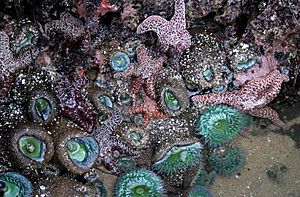
Intertidal zones are areas close to the shore that are covered and uncovered by the ocean's tides throughout the day. Many different kinds of life can be found here. These areas are often full of scavengers that eat sea life washed up on the shore. Many land animals also use these habitats. Some creatures in this zone even bore into rocks, slowly wearing them away.
Estuaries: Where Rivers Meet the Sea
Estuaries are also near the shore and affected by the tides. An estuary is a partly closed body of water where one or more rivers flow into the sea. They are a mix of fresh river water and salty ocean water. The changing water flows bring in lots of nutrients, making estuaries some of the most productive natural habitats on Earth.
Reefs: Underwater Cities
Reefs are some of the busiest and most diverse habitats in the world. The most famous are tropical coral reefs, found in warm waters. But reefs can also exist in cold water. Corals and other animals that make calcium build reefs, usually on rocky parts of the ocean floor. People can also create artificial reefs. Coral reefs support a huge community of life, including many kinds of tropical fish and other organisms.
Scientists pay a lot of attention to coral reefs, especially because of events like El Niño. In 1998, many coral reefs around the world suffered from "bleaching" because sea temperatures got too high. This caused large parts of the reefs to die. While some reefs are getting better, scientists worry that global warming could harm even more reefs.
The Open Ocean
The open ocean is the vast area of deep sea beyond the continental shelves. It doesn't have as many nutrients as coastal areas, but because it's so huge, it still produces a lot of food for the planet. The open ocean is divided into different zones based on depth and how much light they get. The photic zone gets sunlight, while the aphotic zone is completely dark. Much of the energy in the dark zone comes from dead plants and animals sinking from above.
The Deep Sea and Trenches
The deepest part of the ocean ever found is the Mariana Trench, near the Philippines, in the Pacific Ocean. It's about 10,924 meters (35,840 feet) deep! At these depths, the water pressure is extreme, and there is no sunlight. But life still exists! Scientists have seen flatfish, shrimp, and jellyfish there.
The deep sea is generally considered to start where sunlight can no longer reach. Many creatures living here can make their own light, a process called bio-luminescence. Marine life also gathers around seamounts (underwater mountains) where fish come to lay eggs and feed. Hydrothermal vents (hot springs) and cold seeps (cold springs) on the ocean floor are like oases. They support unique life forms, and many new microbes and other creatures have been discovered there.
Related pages
Images for kids
-
HMS Challenger during its pioneer expedition of 1872–76
See also
 In Spanish: Biología marina para niños
In Spanish: Biología marina para niños


